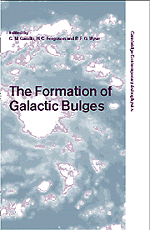Book contents
- Frontmatter
- Contents
- Preface
- Dedication: In Memory of Olin Eggen
- Part 1 Introduction
- Part 2 The Epoch of Bulge Formation
- Part 3 The Timescales of Bulge Formation
- Part 4 Physical Processes in Bulge Formation
- The Role of Bars for Secular Bulge Formation
- Bars and Boxy/Peanut-Shaped Bulges: An Observational Point of View
- Boxy- and Peanut-Shaped Bulges
- A New Class of Bulges
- The Role of Secondary Bars in Bulge Formation
- Radial Transport of Molecular Gas to the Nuclei of Spiral Galaxies
- Dynamical Evolution of Bulge Shapes
- Two-Component Stellar Systems: Phase-Space Constraints
- Central NGC 2146 – A Firehose-Type Bending Instability?
- Bulge Formation: The Role of the Multi-Phase ISM
- Global Evolution of a Self-Gravitating Multi-Phase ISM in the Central Kpc Region of Galaxies
- Part 5 Bulge Phenomenology
- Part 6 Conference Summary
- Index
The Role of Bars for Secular Bulge Formation
from Part 4 - Physical Processes in Bulge Formation
Published online by Cambridge University Press: 10 November 2010
- Frontmatter
- Contents
- Preface
- Dedication: In Memory of Olin Eggen
- Part 1 Introduction
- Part 2 The Epoch of Bulge Formation
- Part 3 The Timescales of Bulge Formation
- Part 4 Physical Processes in Bulge Formation
- The Role of Bars for Secular Bulge Formation
- Bars and Boxy/Peanut-Shaped Bulges: An Observational Point of View
- Boxy- and Peanut-Shaped Bulges
- A New Class of Bulges
- The Role of Secondary Bars in Bulge Formation
- Radial Transport of Molecular Gas to the Nuclei of Spiral Galaxies
- Dynamical Evolution of Bulge Shapes
- Two-Component Stellar Systems: Phase-Space Constraints
- Central NGC 2146 – A Firehose-Type Bending Instability?
- Bulge Formation: The Role of the Multi-Phase ISM
- Global Evolution of a Self-Gravitating Multi-Phase ISM in the Central Kpc Region of Galaxies
- Part 5 Bulge Phenomenology
- Part 6 Conference Summary
- Index
Summary
The purpose of this paper is to describe the dynamics in bars as predicted by classical mechanics, and its relationship with bulge structure and evolution. From physical ground the tight dynamical relationship between small bulges (spheroidal looking structures about as large or smaller than the disk scale-length) and bars leads to doubt that they are decoupled and dynamically independent structures, as often assumed in bulge-disk decompositions or bulge modeling. For big bulges (spheroidal structures much larger than the disk scale-length) the link with bars is looser or indirect, such as a common origin through a merger. Simulations show that big bulges may result from mergers any time after disk formation. Therefore, dynamics indicates that the age of bulges is not a generally well defined concept for bulges, because the formation of a large fraction of bulges can occur much later than the formation of their present material content, the stars. More likely, if bulges are made for a substantial part of a mixture of disk material older than 1 Gyr (otherwise they would not be called bulges) the age spread of the stars is comparable to the age of the oldest stars, thus the ill-defined definition of bulge ages. In turn, the better understanding of all the possible origins of bulges contributes to a revision of the interpretation of the Hubble sequence, which appears as a broad aging sequence of individual galaxies, from late to early types. […]
- Type
- Chapter
- Information
- The Formation of Galactic Bulges , pp. 95 - 114Publisher: Cambridge University PressPrint publication year: 2000



